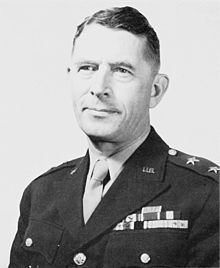Years of service 1916–1948 | Name Ralph Smith | |
 | ||
Born November 27, 1893South Omaha, Nebraska ( 1893-11-27 ) Allegiance United States of America Battles/wars Pancho Villa Expedition World War I:Meuse-Argonne OffensiveWorld War II:Gilbert and Marshall Islands campaignBattle of Saipan Battles and wars Meuse-Argonne Offensive, World War II, Gilbert and Marshall Islands campaign, Battle of Saipan Similar People Holland Smith, Richmond K Turner, Chester W Nimitz, Harry W Hill, Chuichi Hara | ||
Major General Ralph Corbett Smith (November 27, 1893 – January 21, 1998) was a senior officer of the United States Army. After receiving early training as a pilot from Orville Wright he served Brigadier General John J. Pershing's army against Pancho Villa, became decorated for bravery in World War I and commanded the 27th Infantry Division in combat in the Pacific War in World War II. At his death Smith was the oldest surviving general officer of the Army.
Contents
Early life
Born in Nebraska, Smith attended Colorado State College and served in the Colorado National Guard. He was an early aviator and was given flying lessons, as a young officer, by Orville Wright, and his pilot's license, signed by Wright, bore the number 13 because he was the 13th person to receive one.
He was commissioned as a second lieutenant into the Infantry Branch of the United States Army in 1916 and was involved in the Army's unsuccessful Mexican Punitive Expedition, whose Commanding General (CG) was Brigadier General John Pershing, against Pancho Villa, just before the American entry into World War I in early April 1917.
During World War I Smith was awarded the Silver Star with an Oak-Leaf Cluster for two instances of bravery while serving with the American Expeditionary Force (AEF) on the Western Front. He was sent overseas with the 16th Infantry Regiment, part of the 1st Division towards the end of 1917, later being transferred to the 4th Infantry Division. He was wounded in action in the Meuse-Argonne Offensive in the latter half of 1918 and served in occupation duties in Germany after the war.
Between the world wars his duties including teaching at the United States Military Academy and attending, and then instructing, at the Command and General Staff School at Fort Leavenworth, Kansas.
He was a temporary colonel when the United States entered World War II in December 1941. In 1942, promoted to brigadier general, he served as an assistant division commander of the 76th Infantry Division and later became a major general and took command of the 27th Infantry Division. In 1943, his division captured Makin Atoll in the Gilbert Islands while fighting in the Pacific, which became the first central Pacific island to be reconquered by the Allies. In 1944, his division took part in the hard struggle for the mountainous island of Saipan in the western Pacific during which he was relieved of his command by Lieutenant General Holland Smith of the U.S. Marine Corps, commander of the V Amphibious Corps. Marine General Smith contended that under Army General Smith the 27th Division had "failed to attack on time," costing vital Marine lives to save the island.
An all-Army board of inquiry later exonerated Smith, and he went on to briefly command the 98th Infantry Division before going on to serve as the military attaché at the United States Embassy in Paris and CARE's chief of mission for France. While he worked for CARE he also oversaw operations in other western European countries.
Smith retired from the Army in 1948.
After retirement
General Smith was a fellow at Stanford University's Hoover Institution on War, Revolution and Peace.
He died in 1998 of a lung ailment.
Personal life
His first wife, Madeleine, died in 1975.
In 1980, he remarried, to Hildy Jarman, she died in 1995.
